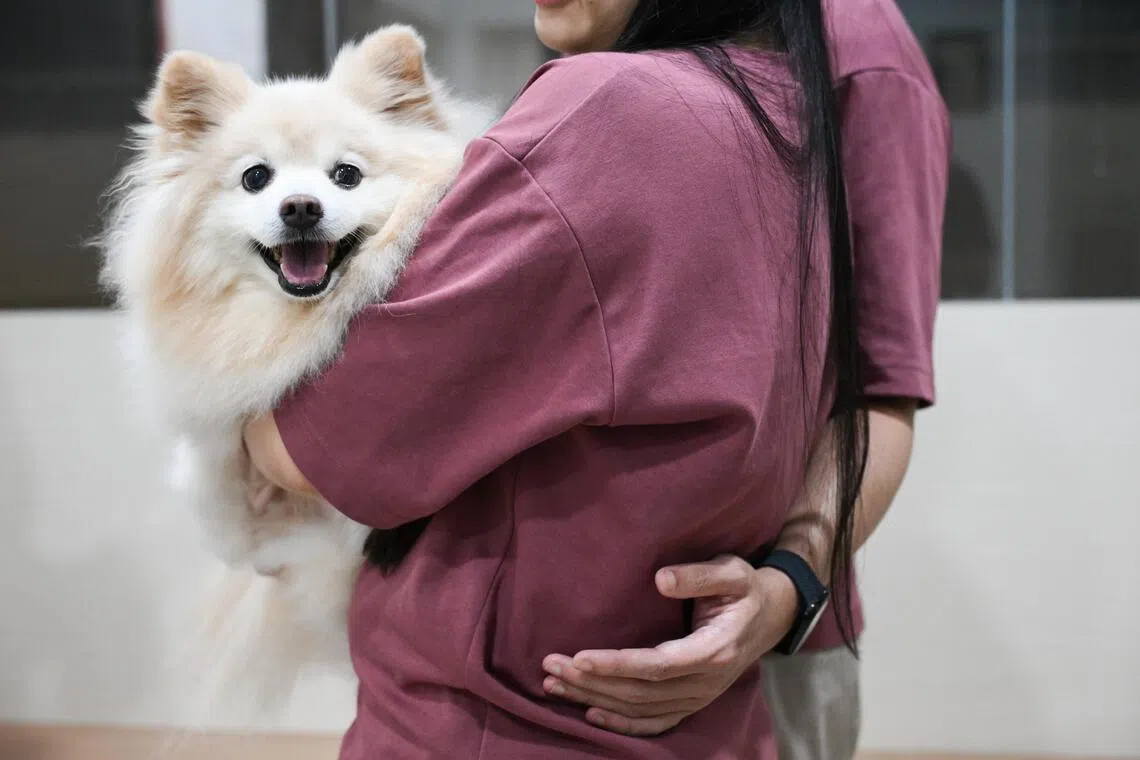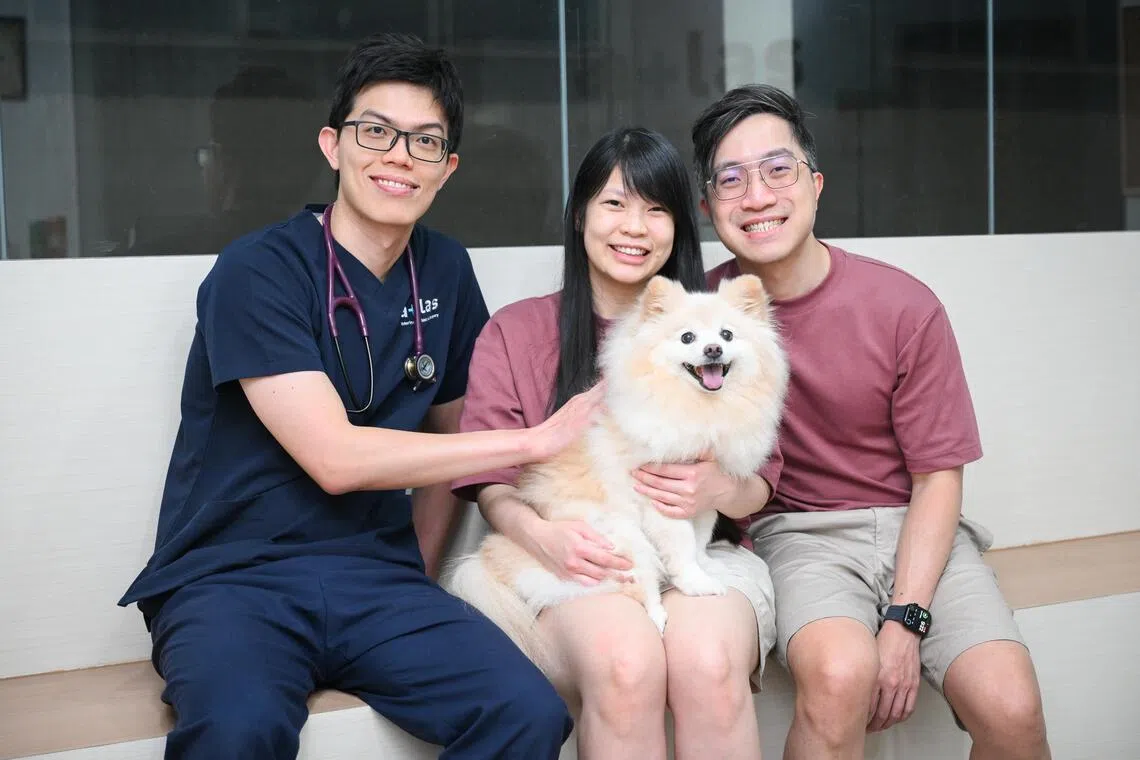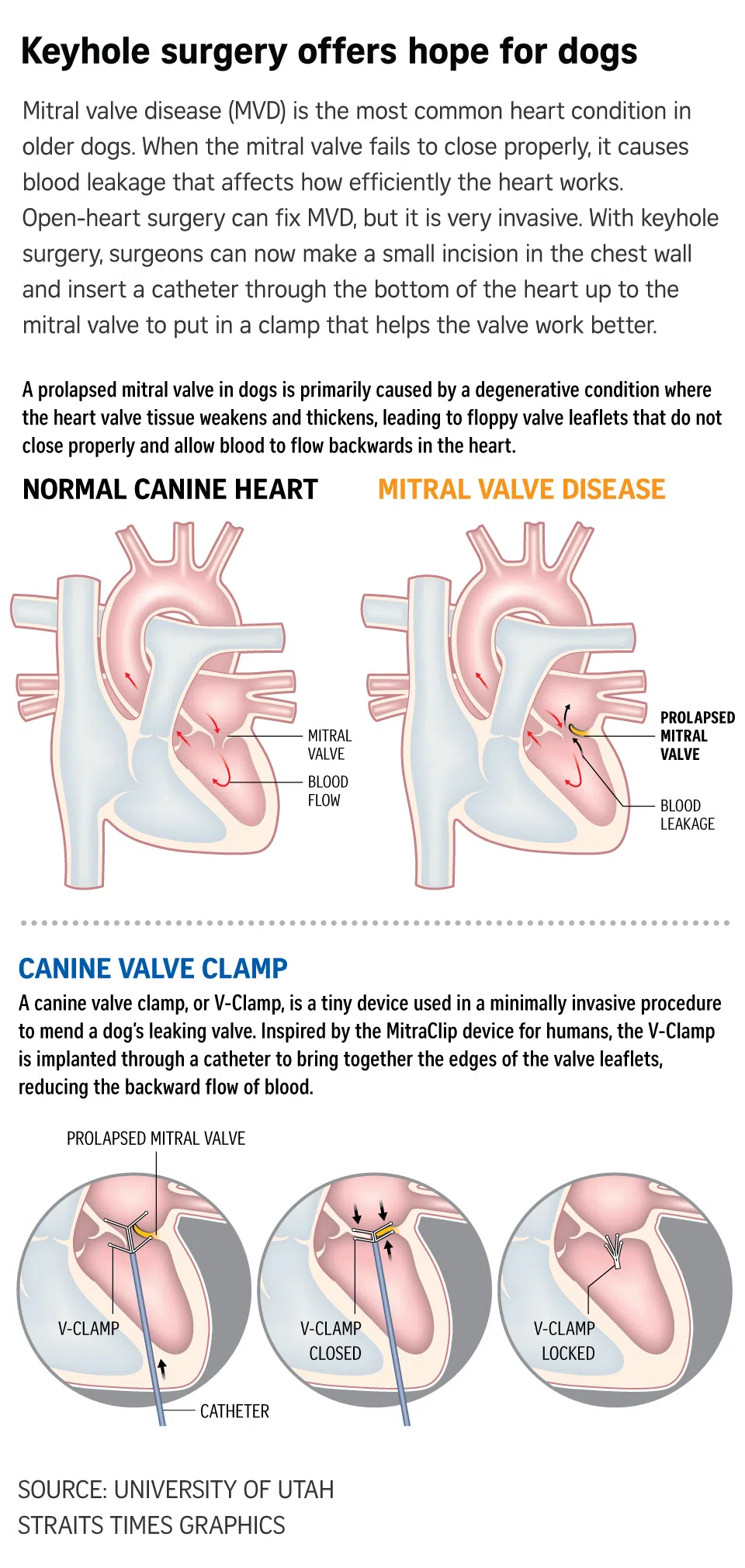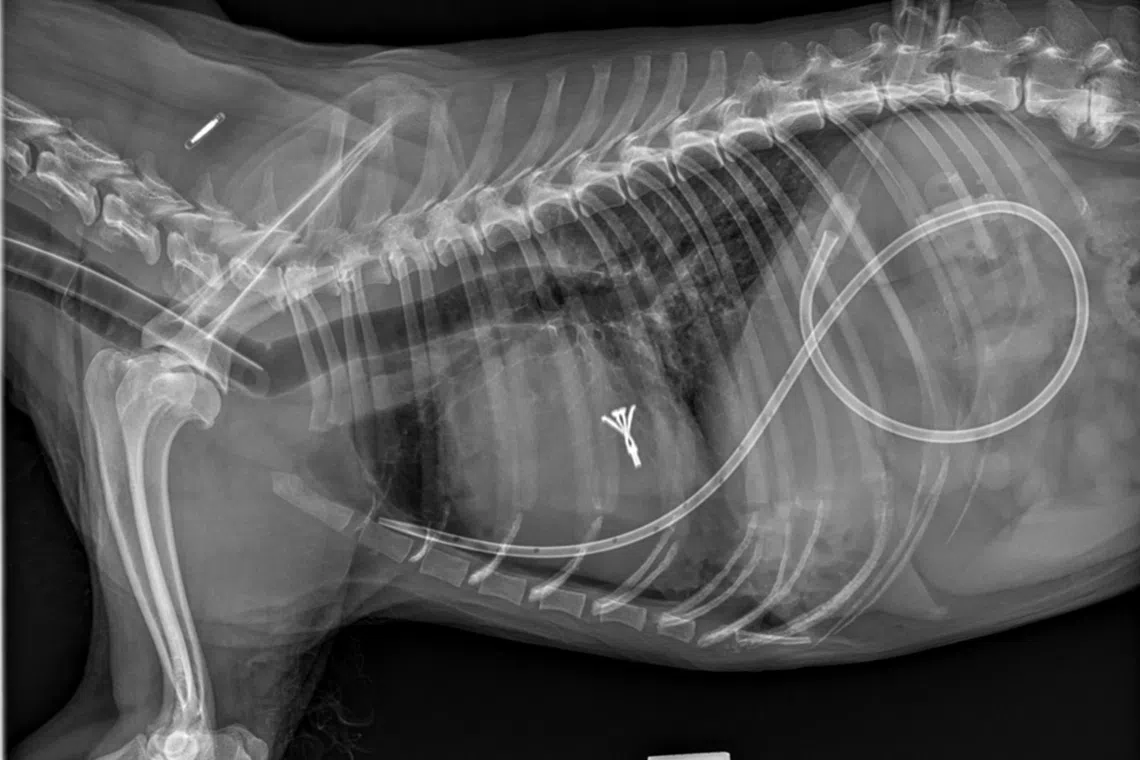Minimally invasive surgery offers hope for older dogs with heart valve disease in S’pore
Sign up now: Get ST's newsletters delivered to your inbox

Snowy, an 11-year-old pomeranian, was given a new lease of life after she underwent Transcatheter Edge-to-Edge Repair surgery.
ST PHOTO: SHINTARO TAY
Follow topic:
- Pomeranian Snowy's severe mitral valve disease (MVD) worsened, making her unsuitable for open-heart surgery. Her owners chose keyhole surgery instead.
- Vet Chow Haoting performed the novel, minimally invasive Transcatheter Edge-to-Edge Repair (TEER) using a V-Clamp, inspired by human MitraClip, to treat Snowy's MVD.
- TEER offers lower risk than traditional surgery, reversing heart enlargement with shorter recovery. Snowy recovered well, allowing her owners to resume honeymoon plans.
AI generated
SINGAPORE – Snowy, a pomeranian, was 11 years old when her bouts of rapid breathing related to a heart condition worsened.
An earlier ultrasound in 2022 had shown she had mitral valve disease (MVD), a condition where the mitral valve, which separates the left upper and lower heart chambers, fails to close properly, allowing blood to leak backward.
MVD is the most common heart disease in dogs, and is particularly prevalent in small to medium-sized breeds, and middle-aged to older dogs.
“The scan picked up her heart disease during her annual check-up, and we managed with medication. Unfortunately, Snowy suffered two episodes of heart failure,” her owner Esther Cheng, a 34-year-old administrative officer, told The Straits Times.
Snowy’s MVD was at Stage D heart failure, which meant she was not a candidate for traditional open-heart bypass surgery. Stage D MVD is when a dog develops an enlarged heart and experiences severe, end-stage congestive heart failure. The usual medication to manage the condition also becomes ineffective.
Ms Cheng’s husband Jason Ong, 34, who had to postpone his honeymoon with her in 2024 because of Snowy’s fast deteriorating condition, said: “(Snowy) had to go back to the clinic every three months to monitor her condition. That was when our vet suggested we go consult Dr Chow, saying he was trained in a new technique to mend the heart without the risk of open-heart surgery. It would give her a fighting chance.”

Dr Chow Haoting of Atlas Veterinary Clinic and Surgery with Ms Esther Cheng, Mr Jason Ong and their dog Snowy.
ST PHOTO: SHINTARO TAY
Mr Ong, a human resource business partner, was referring to veterinarian Chow Haoting. The technique that Dr Chow practises is the Transcatheter Edge-to-Edge Repair (Teer), a novel, minimally invasive technique to treat severe mitral valve disease.
“Instead of open-heart surgery, I make a small opening from the side of the chest and introduce a V-Clamp device (canine valve clamp) through a catheter into the dog’s beating heart, guided by video X-rays and a 3D heart scan,” Dr Chow, 36, explained.

Snowy underwent Teer in March 2025. The first dog to undergo the procedure here was a nine-year-old maltipoo named Dingding. She was operated on in October 2024, a month after Dr Chow was trained in the procedure in Shanghai.
Inspired by the MitraClip device for humans, the V-Clamp – approximately 8mm in length – clips the leaky mitral valve leaflets together, reducing the backflow of blood into the heart chambers and improving its function.
It also slows down congestive heart failure, and scientific literature said it reduces the severity of the mitral valve leak by between 50 per cent and 90 per cent.
The procedure is carried out while the heart is still beating – a marked difference from the traditional open-heart surgery, where the veterinary surgeon needs to cut through the breastbone to expose the heart and a heart-lung bypass machine is used as the animal’s heart is stopped.
“The risk of Teer surgery is lower compared with conventional open-heart surgery. The dog also takes a shorter time to recover, reducing the stay at the animal hospital. The animal will also potentially have a better quality of life and longer life expectancy,” said Dr Chow, who was with the Society for the Prevention of Cruelty to Animals before he started his own practice, Atlas Veterinary Clinic and Surgery, in 2021.
Teer surgery typically costs between $16,000 and $20,000, while open-heart surgery can go up to $50,000.
Training in China
It was early 2024 when Dr Chow was invited to undergo Teer training in Shanghai under the Veterinary Learning Exchange Programme.
“Our team of four, myself included, went to Shanghai for a week in May 2024, and we paid US$10,000 (S$12,900) for the training. I flew back to Shanghai again in September to hone my skills further,” Dr Chow said.
A month later, he carried out his and Singapore’s first Teer surgery on Dingding. Dr Chow was then the president of the Singapore Veterinary Association.
Dingding had end-stage MVD and was given a prognosis of only three months.
Her owner, Mr Jimmy Kwan, an engineering manager in his 40s, said: “She started having hiccups often in 2023, so I took her to the vet. She had an X-ray done and that was when the vet discovered fluid in her lungs. She was diagnosed with heart failure and given medication to manage the issue.”
Although Dingding’s condition was managed with the medication, by the time her next check-up came, 1½ years later, her condition had worsened.
“As she is like my own child, I wanted to fly her to Japan to have corrective surgery done. It was risky, but since there was no other choice, I would have done so. It was then that my own vet told me about Teer, and said Dr Chow was trained in the procedure. Since it offered hope, I decided to have it done,” he said.
Said Dr Chow: “As Dingding was the first, the team from Shanghai was flown in to Singapore for the surgery. We also had a professor from the University of Calgary in Canada who specialises in cardiac anaesthesia fly in for anaesthesia support.”
The entire operation took about 90 minutes – one-third of which was used to position and deploy the clamp, Dr Chow said.
Dingding was able to go home after being warded and monitored at Atlas Vet for just two nights. Today, the maltipoo is healthy and does not need the medication to manage her heart.
Dr Chow has since carried out Teer surgery to correct the MVD in 11 dogs, and each time, the team from Shanghai has flown in to provide support.

Two hours after Dingding’s surgery, her heart is smaller, after a clip was put in place to repair the valve prolapse. There is a temporary chest tube placed for monitoring purposes.
PHOTO: ATLAS VET
But Dr Chow said not all dogs are suitable for the procedure.
“The surgery is primarily for smaller breeds of dogs in the late stages of MVD. Eligibility is also determined by a thorough heart evaluation, which includes imaging. Should there be a crack in the heart where the clamp is supposed to be positioned, then the dog is not suitable. This can be indicated through the scans,” he explained.
Risks include common complications like bleeding at the catheter site, device-related issues such as misplacement, and more serious but infrequent ones such as stroke, heart attack, or a collection of blood around the heart.
Fortunately for Snowy, she has recovered and is back to her active self, to the relief of her owners.
“Now, we are able to confidently leave her with my parents, and we can resume our plans to go on our honeymoon in Japan,” Ms Cheng said.


